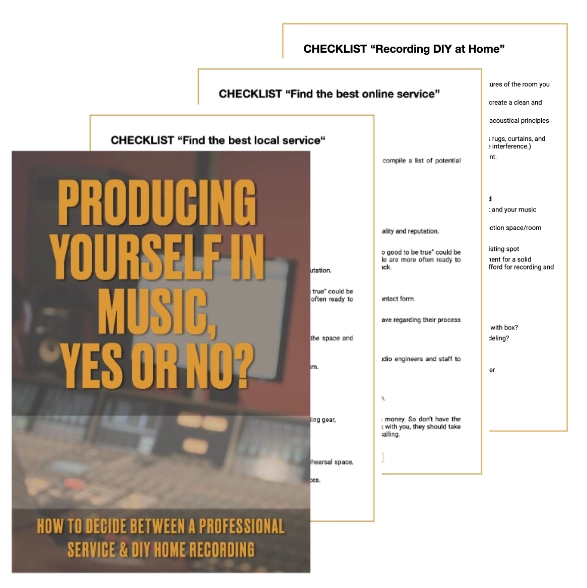Unlock Your Music Production Potential: A Comprehensive Guide to Starting Your Home Recording Journey
I’m thrilled to share with you in this episode seven essential steps to start your home recording journey. Whether you’re hoping to lay down your first track or refine your existing setup, this episode is your first go-to resource.
Transform Your Space!
The first step in your home recording adventure is establishing a dedicated, comfortable recording space. To foster creativity, it’s vital to assess your available area—consider the layout, size, and existing features that could enhance your acoustic environment. Could a corner of your bedroom suffice? Or maybe an unused dining space?
A well-organized recording environment not only helps you save time but also allows you to record, mix, and create music whenever inspiration strikes.
Understand Your Acoustics
Next, is about acoustic understanding. Knowing how sound behaves in your chosen space is crucial; this includes being aware of echoes, outside noise, and how to achieve that dry sound ideal for vocal recordings. A quiet, well-treated room is a fundamental part of producing high-quality recordings without interruptions.
Set the Right Mood
Lighting and air quality can significantly impact your creative output. I emphasize the importance of ambient lighting that complements your recording style and creating an atmosphere that inspires your music creation. Keeping your space ventilated and fresh is also key to maintaining focus during long recording sessions—a little thought in this area goes a long way!
The Right Recording Source
The heart of your production lies in understanding your recording sources. Are you recording vocals, electric guitar, or perhaps an acoustic drum set? Each source requires specific strategies for capture, and I cover crucial components like mic choices, isolation needs, and sound generation. If you’re short on space, you’ll learn how to use MIDI equipment and virtual instruments effectively, providing flexibility without sacrificing quality.
Assemble Your Recording Chain
What gears connect your creative intent to your digital audio workstation (DAW)? I discuss building an effective recording chain, emphasizing that it’s not just about having the most expensive equipment but rather the right tools for your needs. From microphones to cables and interfaces, understanding what each piece does is key.
With today’s technological advancements, even mid-range computers can sufficiently manage home production tasks.
Choose Your DAW Wisely
I tackle the world of digital audio workstations (DAWs), explaining how to select the software that complements your workflow. Compatibility matters, but so does user experience—finding a DAW you enjoy navigating can make all the difference in enhancing your creative process.
Invest in Monitoring
An often-overlooked aspect of home recording is the monitoring system. Whether you opt for studio monitors or high-quality headphones, I help you understand how to select a system that works for your space—maximizing sound fidelity without disturbing neighbors.
Learning Resources
Finally, we delve into the importance of ongoing education. From YouTube tutorials to online courses, investing in knowledge is essential for refining your skills. I provide recommendations on where to look, including specific themes like recording, mixing, and acoustic optimization.
I also share insights on the significance of mentorship and resources tailored to your unique goals.
Conclusion
If you’re still on the fence about starting your home recording journey, don’t hesitate to check out my comprehensive eBook „Producing yourself in music – yes or no?“, a step-by-step guide designed to assist you in making the best decisions for your music production journey. You don’t have to go at it alone—resources are available.
Tune in to discover how these seven foundational points can elevate your home recording game!
For more details, and to access the eBook, visit jokertonecourse.com/producingyourself.

Key topics and takeaways of the Episode
1. Recording Space – Your Ideal Environment for Music Production
Overview: Your recording space is the foundation of your home studio; choosing the right environment makes all the difference in your music’s sound.
Takeaways:
- Evaluate your space for size and acoustics.
- Clear out unnecessary items for a more organized, productive setup.
- If possible, dedicate a small corner for music production to keep your workflow efficient and uninterrupted.
2. Recording Source – Know What You’re Recording
Overview: Understand the type of sound you’re recording, whether it’s vocals, guitars, or drums, to select the right gear and optimize your space.
Takeaways:
- Different recording sources require different setups, from microphones to room treatment.
- If you have limited space, consider virtual instruments like MIDI drums instead of real acoustic kits.
- Tailor your environment to match your recording needs, ensuring optimal sound isolation and acoustic treatment.
3. Recording Chain – Get the Right Gear for Your Sound
Overview: The recording chain consists of all the gear used to capture your sound, from microphones to cables; using the right equipment ensures a clean, professional recording.
Takeaways:
- Choose the right microphone for your recording source (e.g., condenser for vocals, dynamic for amps).
- Invest in quality mic stands, cables, and pop filters to reduce noise and ensure reliability.
- Don’t skimp on the basics; mid-range gear often offers the best balance between quality and affordability.
4. Computer & Interface – Bringing Your Sound into the Digital Realm
Overview: Your computer and audio interface are the bridge between the analog and digital world, and selecting the right ones ensures smooth recording and mixing.
Takeaways:
- Your computer doesn’t need to be high-end—focus on storage space and processing power.
- Choose an audio interface with enough inputs and preamps to support your recording setup.
- Understanding your interface’s monitoring capabilities helps you get real-time feedback without latency issues.
5. Recording Software (DAW) – Choose the Right Digital Audio Workstation
Overview: The DAW is the software you’ll use to record, edit, and mix your music, so picking the right one is key to a smooth production process.
Takeaways:
- Choose a DAW that’s compatible with your computer and interface, with features you’ll actually use.
- Don’t overcomplicate things—many affordable DAWs have all the basic tools you need to produce professional music.
- Focus on mastering the basics of editing, MIDI, and routing before exploring advanced features or external plugins.
6. Monitoring System – Hear Your Sound Accurately
Overview: A quality monitoring system helps you hear your recordings clearly, ensuring your mixes translate well across different playback systems.
Takeaways:
- Choose the best speakers or headphones you can afford, tailored to your room size and needs.
- Proper speaker placement and room acoustics play a huge role in achieving accurate sound.
- If your space doesn’t allow for speakers, invest in high-quality headphones for recording and mixing.
7. Learning Resources – Never Stop Improving
Overview: Continuous learning is vital to becoming a better music producer; utilizing the right resources helps you stay on top of your game.
Takeaways:
- Look for YouTube channels, books, and online courses that match your learning style and goals.
- As you progress, consider online courses or private lessons to get more personalized feedback.
- Stay curious—knowledge about recording, mixing, and mastering will help you produce the best sound possible.
Conclusion:
By following these 7 essential steps—setting up your recording space, understanding your recording source, selecting the right recording chain, investing in your computer and interface, picking the right DAW, building a solid monitoring system, and continuously learning—you’ll be on your way to producing professional music in no time. Tune into the full episode for more detailed advice, and take the next step in your home recording journey today!

